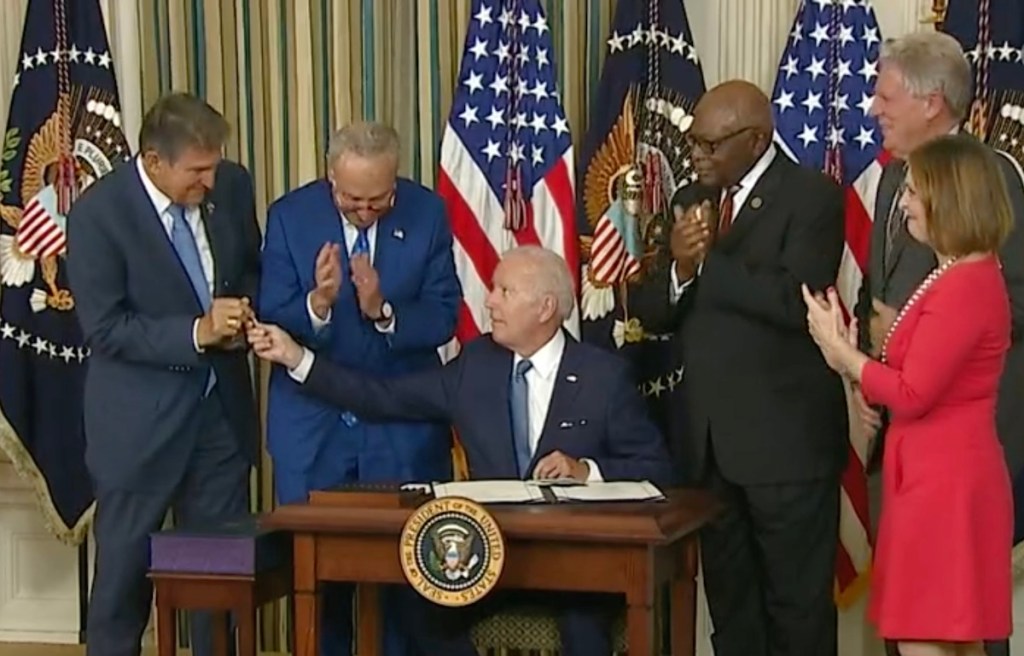“Hug a tree!” said Sigrid Wright, enthused about President Biden’s signing on Tuesday of the historic transitional energy bill known as the Inflation Reduction Act. Wright leads the Community Environmental Council in Santa Barbara, a nonprofit that has since the 1970s worked toward a sustainable planet on the local level. “This law represents a long-overdue economic shift away from fossil fuels and finally does for the nation what California’s been and the Community Environmental Council has fought for locally: giving clean energy a competitive edge.”
The anti-inflation act passed the Senate on August 7 as a reconciliation bill that allows a 50-plus-one vote; Vice President Kamala Harris was the tiebreaker on the strictly partisan tally — not one Republican voted for it. It passed the House on August 12, again with no Republican votes. California Senator Alex Padilla said of the bill: “Democrats in Congress are taking on special interests to deliver for working families. This bold and transformative bill will fight inflation, lower health-care costs, and make the largest investment in history to combat the climate crisis.”
The Inflation Reduction Act accomplishes many of the goals in Biden’s Build Back Better Act from last fall but lost universal childcare provisions and middle-class tax cuts. Among the gains, however, are tax credits to corporations for a myriad of green projects, according to Senator Padilla’s office: domestically produced solar panels, wind turbines, batteries, and processing of essential minerals; and pollution-reducing transportation funding for ports, communities, trucks, buses, infrastructure, and airports.
For consumers in California, $9 billion is available for home energy rebates and 10 years of tax credits for appliances that are energy efficient. To start lowering the ever-increasing smog levels in this public-transportation-poor state, the bill offers up to $4,000 in tax credits for used clean-energy vehicles for low- and middle-income individuals and families. As much as $7,500 is offered for new vehicles purchased by individuals and businesses, though the restrictions include a percentage of U.S. manufacture for vehicle and batteries, and a sticker limit of $55,000 on sedans and $80,000 on SUVs, vans, and trucks.
Other individual pocketbook targets are a three-year extension of subsidies for Affordable Care Act insurance payments, which will affect nearly two million Californians. The bill caps at $2,000 the out-of-pocket costs of Medicare recipients, who number 6.5 million in California. Beginning in 2023, Medicare will be able to start negotiating prescription drug prices. The cost of insulin is capped at $35 per month, but only for Medicare recipients; for people needing insulin but not on Medicare, the reconciliation process could not include them, the Senate Parliamentarian ruled.
Sign up for Indy Today to receive fresh news from Independent.com, in your inbox, every morning.
As for higher taxes, the total revenue raised is mainly targeted toward large corporations; families and small businesses earning less than $400,000 have no new taxes. The 15 percent corporate tax is expected to raise $222 billion for the U.S. Treasury annually as an alternative minimum tax for enterprises earning more than $1 billion. A one percent fee on stock buybacks will raise $74 billion: This was added to offset the loss from a demand by Democrat Senator Kyrsten Sinema of Arizona to preserve a tax loophole known as “carried interest” — hedge fund and private equity managers and executives are paid in investment gains that are taxed at the 20 percent capital gains rate; the bill sought to impose the current 37 percent income tax rate instead.
The Internal Revenue Service received $45.6 billion more in tax enforcement funding, among other new funding, an outlay that is expected to net $124 billion annually.
Tree huggers might be happy with this bill. About $5 billion goes toward healthy forests and urban tree planting, including $1.8 billion specifically to reduce wildfires and protect communities; another $1 billion goes to National Park Service and Bureau of Land Management conservation. About $60 billion goes to clean up pollution, especially pollution sources affecting low-income areas. And $4 billion goes toward drought measures in Western states — with priority for the Colorado River basin and inland seas like California’s Salton Sea — and $2.6 billion to conserve coastal habitats.
Whether the bill’s provisions will affect the global climate crisis is up for debate. Forest work is controversial, as recent disputes in Los Padres National Forest have broken out. New oil and gas lease provisions were forced into the bill by Democrat Senator Joe Manchin of West Virginia. Skeptics point out that industrialized countries, like China and India, show no signs of slowing their engines of progress. With this bill, however, the U.S. has rejoined the international community that is acting to suppress greenhouse gas production and also given its citizens a boost toward saving on the costs of health care and ditching their gasoline-consuming vehicles.
Correction: The new 15 percent corporate book tax is unrelated to the global push for a corporate tax of similar size.
Support the Santa Barbara Independent through a long-term or a single contribution.

